AND The life of a modern person living in his own house cannot be imagined without the comfort and convenience that various household electrical appliances provide him. People are so accustomed to most of the useful functions of electrically powered home assistants that they often do not pay attention to them, taking them for granted. But electricity can not only create comfortable living conditions, but also carries a certain danger. To reduce the likelihood of this danger, do-it-yourself grounding in a private house 220V is required.
General scheme of the grounding device
A grounding device for your own home is required for several reasons.
There are specific rules that oblige to ground the house - otherwise you can get a very serious fine. In addition, some devices, without which comfort in a private house is impossible (for example,), simply cannot be operated without this protection.
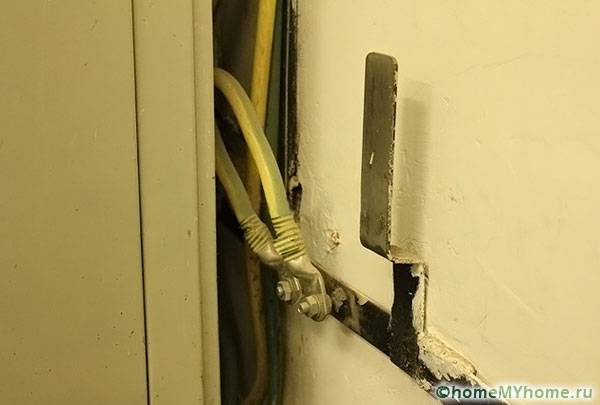
The main purpose of the current protection device is to eliminate the risk of electric shock from touching the body of any household electrical appliance. If the wiring is damaged, for example, a phase hangs on its body. One has only to touch the device, and you can get a very sensitive electric shock, which can be fatal. In the presence of protection, the current will simply run away along the path of least resistance.
The correct grounding device helps to minimize the amount of interference in the mains. It also significantly reduces electromagnetic radiation, which negatively affects the well-being and health of living people.
Ground types
Two types of grounding are used in a private house, arranged with their own hands 380V and 220V: working and protective.
Working
It is arranged mainly in order to prevent a sudden increase in voltage in household appliances that occurs as a result of a violation of the insulation of the transformer winding. Effective protection is also provided when lightning strikes a building - due to the fact that the entire discharge goes into the ground, household appliances do not fail.
Protective
This type is arranged by forcibly connecting the electrical appliance case to the ground through the conductor. As a rule, for the device of such grounding, the presence of sockets with a grounding terminal is sufficient, but some types of equipment require additional protection.
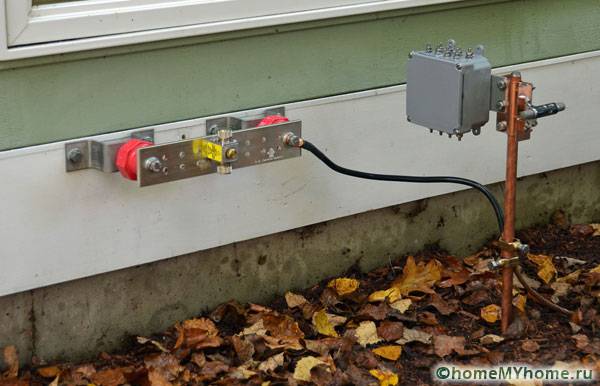
Protective grounding must be provided for the following household current consumers:
- . Its operation takes place in conditions of high humidity, while the case has a large electrical capacitance.
- Microwave. The main element of this device is a high power magnetron. If the ground contact in the socket is insufficient, a significant increase in the level of electromagnetic radiation is possible. Most manufacturers provide for the installation of a terminal on the back of the oven for additional protection.

- Computer. The power supply of this, no doubt, irreplaceable device often creates voltage on the case of the system unit, which is unsafe for the user. Grounding the PC is carried out by connecting the ground wire to one of the screws of the system unit.
- Boiler. Electricity is used to heat water in this device. Any leakage of current to the body of the device, operating in high humidity conditions, is dangerous to humans.
Grounding 220V and 380V: differences
Do-it-yourself grounding in a private house 380V and 220V has only minor differences.
The circuit in both cases is constructed in the same way, the only difference is in the way it is connected to the home power supply system. In a single-phase network with a voltage of 220 V, sockets with three contacts are used: phase, zero and ground electrode. In three-phase networks with a voltage of 380 V, 5 wires and sockets with five poles are used: the same zero and ground, but there are three phases.
Helpful information! It is not allowed to use a neutral wire for grounding in private houses with your own hands 380 V and 220 V - this can damage expensive household electrical appliances, as well as create a real danger to people in the house.
Types of ground electrodes
Grounding conductors can be used in two types:
- natural;
- artificial.
As natural grounding can be metal structures, deeply installed in the ground, or the reinforced concrete foundation of the building.

Artificial ground electrodes used for an independent 220V grounding device in a private house are divided into the following types:
- horizontal - made of round or strip steel, laid in a trench parallel to the ground;

- vertical - segments of a steel corner driven into the soil;

- recessed - products made of strip steel that fit to the bottom of the trench along its perimeter.
For the manufacture of protection devices are mainly used:
- steel round Ø 10-16 m;
- steel strip with a section of 40x4 mm;
- steel corner 50х5х5 mm.

Corners for grounding device
Important! It is highly undesirable to use reinforcement as a grounding conductor - it is made of hardened metal, which has a relatively low electrical conductivity.
Installation of current protection
Location selection
First of all, it is necessary to determine the place where the ground loop will be made, since the safety of the system operation depends on it. When the protection is triggered and the electricity is drained into the ground, neither people nor animals should be in the place of the outlet, as this can lead to death.
It is most convenient to place the outlet behind the house near the fence, stepping back from the edge of the foundation at least 1 meter. To protect the danger zone, it would be useful to erect a small fence.
To hide grounding in a private house with your own hands 220V and 380V, to improve the territory, on this site, for example, you can lay a sculptural composition of boulders. In this case, no one will be able to get too close to the danger zone, and the backyard area will look beautiful.
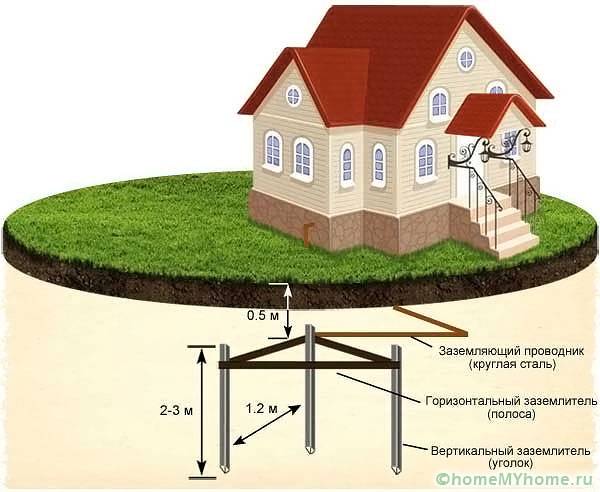
Excavation
Do-it-yourself grounding in a private house 380V circuit consists of three metal conductors immersed in the ground at a distance of 2 m from one another.
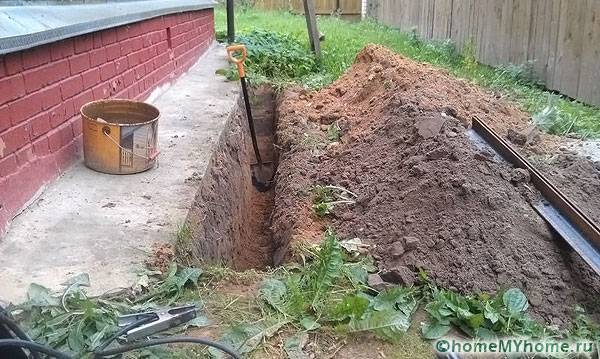
Trench for current protection circuit
A trench shaped like an equilateral triangle with side lengths equal to 2 m is dug with a shovel. Its depth should be 0.5-0.7 m. Exactly the same trench is dug to the porch of the house.
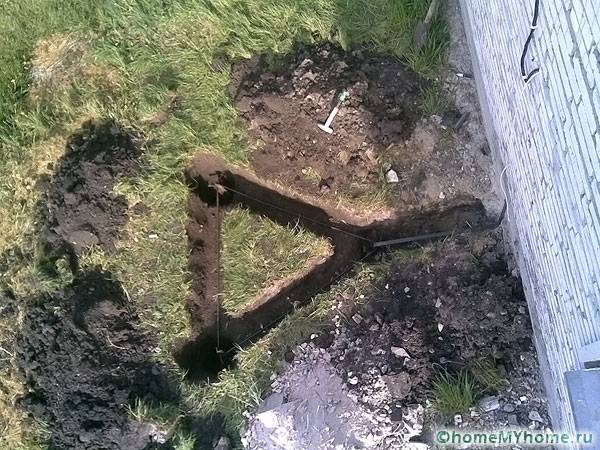
Construction assembly
The assembly of the circuit design can be called the main stage, at which grounding in a private house with a 220V do-it-yourself scheme provides for driving electrodes into the ground to a depth of two meters. At the same time, tops should be left on the surface for tacking by welding.

When driving, the driven end should be slightly sharpened to facilitate driving into the ground.
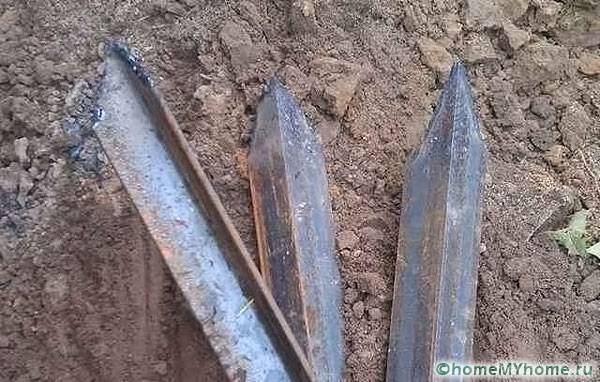
After driving all the pins, plates are welded to their top to obtain a metal frame in the shape of a triangle.
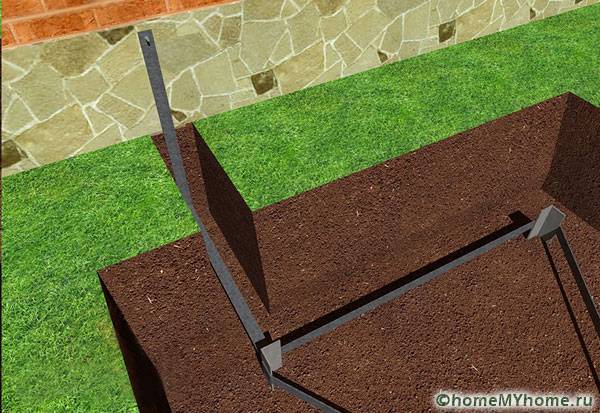
A separate plate must be laid in a trench dug to the porch; it is also attached at one end to the nearest apex of the triangle.


Then a cable is connected to the plate on the bolt, the trenches are covered with soil.
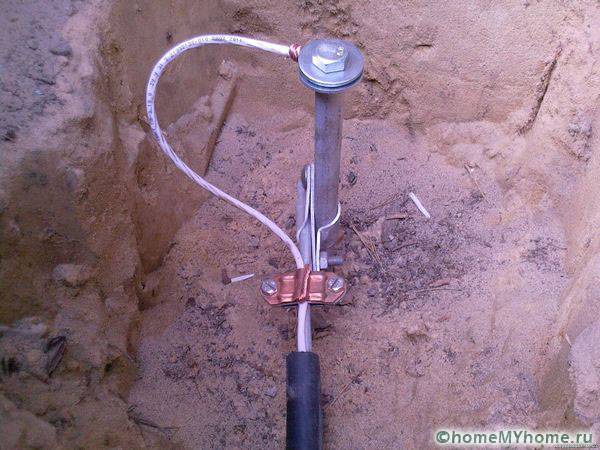
Helpful information! If there are sandy soils at the site of the circuit, their electrical conductivity can be increased with a salt solution. The only drawback of this method is the rapid oxidation of the metal, which will eventually lead to a decrease in grounding power.
Checking the correct installation
Upon completion of work, be sure to measure the resistance of the arranged grounding.
The loop resistance should be:
- for a network with a voltage of 380V - 2 ohms;
- for a network with a voltage of 220V - 4 ohms.
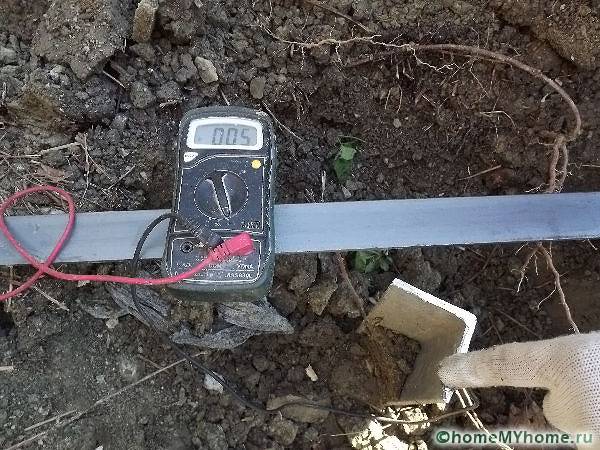
The performance can be easily checked with a lamp with a power of more than 100W. To do this, you need to connect the lamp with one contact to the phase, and the other to the ground loop. The bright light of the lamp indicates the correct installation, dim burning - too weak contact between the contour elements and the need to more responsibly approach the connection of the joints.
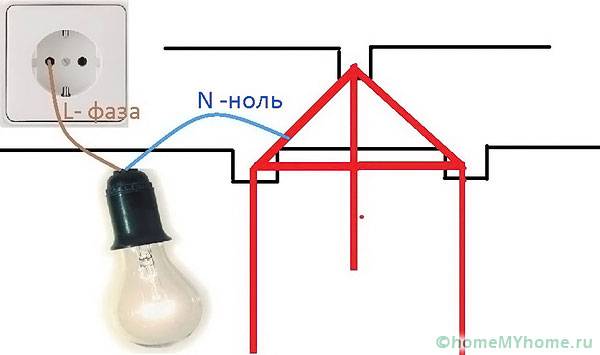
The complete absence of a lamp glow means there is an error, for which it may be necessary to completely check the entire system to eliminate it.
Conclusion
An independent grounding device in your own home cannot be called an impossible task. To solve it, you only need to choose the type of contour and stock up on the required materials and tools. To perform welding work, you can attract friends or hire a specialist, dig trenches - you can do it yourself. If there is not enough knowledge in the field of electrics, you can, again, turn to friends or invite an outside specialist. In any case, do-it-yourself grounding will cost much less than concluding an agreement with a company.



